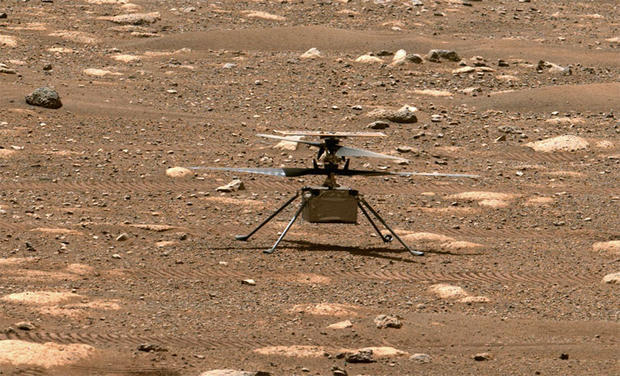NASA's Ingenuity helicopter, grounded Thursday by a pesky-but-understood software issue, successfully completed its fourth flight in the ultra-thin atmosphere of Mars Friday, kicking off a new phase of extended science operations for the $80 million drone.
"Ingenuity successfully completed its fourth flight today, and we couldn't be happier," project manager MiMi Aung said in an on-line status report. "We have lots of data to analyze. Ingenuity's performance on Mars has been letter-perfect. This is an amazing time for our entire team!"
Data from the helicopter, relayed back to Earth via the Perseverance rover and one of NASA's Mars orbiters, confirmed the 4-pound helicopter took off from "Wright Brothers Field" in Jezero Crater around 10:49 a.m. EDT (12:33 p.m. local time on Mars).
It then climbed to an altitude of 16 feet, tilted toward the south and flew some 436 feet out and back again before settling to a touchdown one minute and 57 seconds after liftoff.
Along the way, the small drone captured 60 black-and-white shots of the ground below, along with five color views, data that will be used to build a three-dimensional terrain map to help mission planners identify a new "airfield" for future use.
"Success," the Jet Propulsion Laboratory, where Ingenuity was built, tweeted after data came in confirming takeoff. "#MarsHelicopter completed its 4th flight, going farther & faster than ever before. It also took more photos as it flew over the Martian surface. We expect those images will come down in a later data downlink."
NASA science chief Thomas Zurbuchen tweeted: "Incredible! Congratulations to the team on Ingenuity's 4th flight!"
The 4-pound helicopter, added to the Perseverance rover mission as a technology demonstration, met all of its pre-flight objectives during three near-flawless test flights earlier this month.
As a result, NASA managers decided to expand the drone's mission to include at least one more month of flight operations, putting the rotorcraft to work collecting science data. At the same time, Perseverance will transition from supporting helicopter operations to completing preparations for its own science mission.
"Since Ingenuity remains in excellent health, we plan to use it to benefit future aerial platforms while prioritizing and moving forward with the Perseverance rover team's near-term science goals," Zurbuchen said in an earlier statement.
For the next flight, the helicopter's fifth, "we will send Ingenuity on a one-way flight to transfer to the new airfield," Aung said during a briefing Friday. "After it arrives, we're going to work very closely with (the Perseverance team) to identify the new, operational products and scenarios that we want to test (going) forward. I can't tell you how excited we are about this new phase."
Engineers initially held two test flights in reserve in case Ingenuity failed to meet its primary objectives during the first three. But those no-longer-needed place holders have been turned into transitional flights, bridging the gap between proof of concept and operational demonstrations of aerial exploration capabilities.
"We will now ... work on operational products, such as aerial observation of specific science targets or looking at context features from places that are not accessible by rovers," Aung said. "Another operational product we'll look at is scouting for potential science observations, scouting for a future rover traverse or scouting for new airfields for the helicopter to transfer to.
"We can also look at stereo imaging, digital elevation maps. So as we make these products, the lessons learned from that exercise will benefit future missions with aerial platforms tremendously. And as we pursue these operational products, we will also continue to push the capability of Ingenuity.""
Ingenuity captured the world's imagination with its first flight on April 19, about a month after arriving on Mars with the Perseverance rover. The drone climbed up to an altitude of about 10 feet, hovered briefly and then landed.
It flew a second time on April 22, climbing to 16 feet and flying about seven feet to one side and then back again. For its third flight on April 25, Ingenuity climbed back up to 16 feet and flew 164 feet down range before returning to its starting point.
"When Ingenuity's landing legs touched down after that third flight, we knew we had accumulated more than enough data to help engineers design future generations of Mars helicopters," Bob Balaram, Ingenuity chief engineer at JPL, said in an on-line status report. "Now we plan to extend our range, speed and duration to gain further performance insight."
The team originally planned to launch the helicopter on its fourth flight Thursday, but data beamed back to Earth showed Ingenuity's flight computer failed to transition to flight mode as expected.
A similar problem cropped up April 9 during a rotor spin test prior to the drone's first flight.
At the time, engineers debated whether to erase Ingenuity's flight software and load a modified version from scratch or to simply uplink additional commands that would improve the odds of a successful transition to flight mode.
They decided the latter option posed less risk, but said at the time it was possible the glitch could happen again. Ingenuity then carried out three successful test flights in a row going into Thursday's planned flight when, again, it failed to switch into flight mode.
The system worked normally Friday. Balaram said the team may reassess whether to replace Ingenuity's flight software with a modified version to avoid such problems down the road.
Article From & Read More ( Mars Ingenuity helicopter chalks up record flight as NASA extends its mission - CBS News )https://ift.tt/3xzGKi1
Science


No comments:
Post a Comment